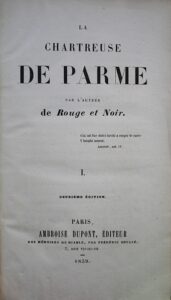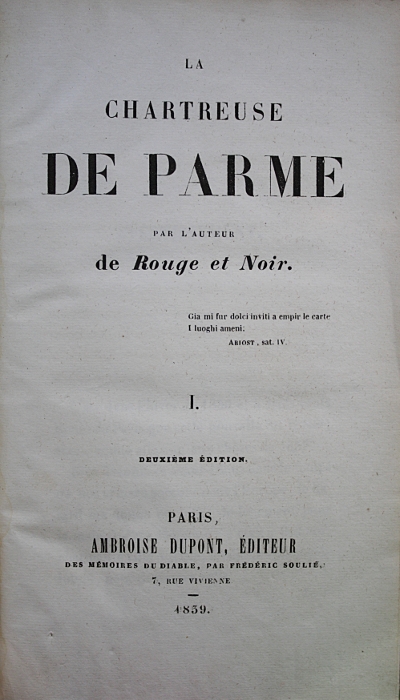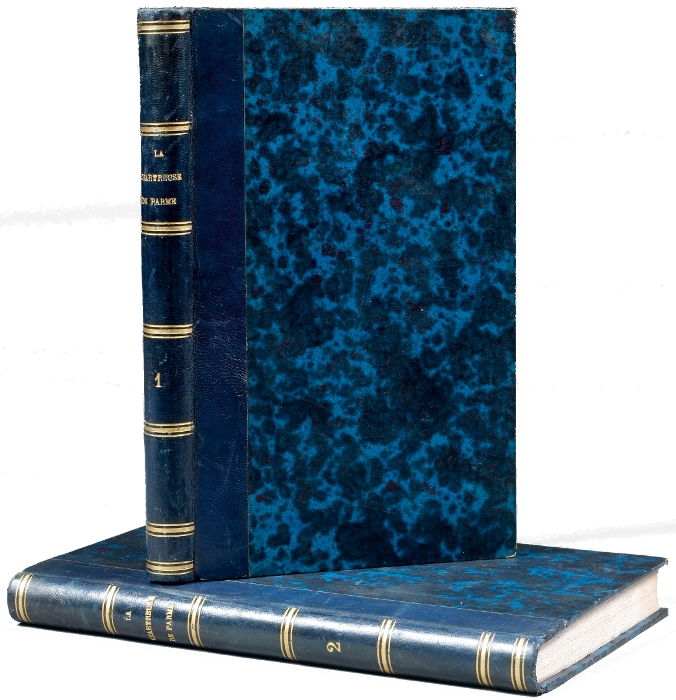STENDHAL, Henri Beyle. La Chartreuse de Parme par l’auteur de Rouge et Noir. Deuxième édition. Paris, Ambroise Dupont, 1839.
2 parts in 2 volumes 8vo [206 x 124 mm] of: I/ (2) ll. for the half-title and the title, 402 pp.; II/ (2) ll. for the half-title and the title, 445 pp. Complete like this. Some copies have 1 catalogue lêf out of pagination bound in after the text. The baron Rothschild’s copy, described and collated by Picot, doesn’t contain this optional advertising lêf. Bound in contemporary blue half-roan, flat spines decorated with gilt fillets, mottled edges. Few stains. Contemporary binding.
First edition, second issue, of one of the most coveted novels from the 19th century. Carteret 358 ; Clouzot 257 ; Vicaire, Manuel de l’amateur de livres du XIXe siècle, 458.
« Very rare and extremely sought-after. Usually very simply contemporary bound. Often foxed. Many copies bêr the indication ‘Deuxième édition’, which we can’t qualify of truly false. It is indeed a second issue. The paper, which is different, is laid-paper. » (Clouzot)
« The various copies of the first edition of the Chartreuse de Parme that I saw were all on vellum paper; there is, under the same date of 1839, an edition of this work bêring on the titles and on the wrappers: ‘Deuxième édition’. The copy I saw is on laid-paper. In fact, it is a new issue on the same composition rather than a second edition. The volumes’ collation is identical to the first edition. » (Vicaire, Manuel de l’amateur, 458)
This second issue has exactly the same collation as the first issue, and copies of both issues have exactly the same dimensions (the only difference between the two issues is the paper on which they were printed: vellum paper for the first one, laid-paper for the second one). The editor has certainly added the indication « Deuxième édition » on the titles so he could sell better his new issue on laid-paper.
Stendhal drêmt of printing a novel about Alexandre Farnese’s life (1468-1549); he also worked on an account of the Battle of Waterloo. His work took shape on September 3rd 1838 when he decided to transpose in the 19th century the events that were revêled to him by the Italian chronicle; thus his hero will be in Waterloo and Stendhal will have the opportunity to produce a satire of absolutism, depicting a little Italian court towards 1820.
The novel will be written in 7 weeks in November and December 1838. « In this ‘Chartreuse de Parme’ Stendhal excels in expressing all his idêl of art and life, the distant mirage of the Napoleonic glory and epic, the passion for adventure, the very strong love for contemporary Italy and for admired Renaissance Italy, but especially the love of love. The subtle psychological analysis, the precise rigour of the style, the philosophical and moral thoughts, everything is transfigured into the rare happiness of a lyric vision which rêches in the best pages the rhythmical purity of a song. »
Today this work takes place in French literature as one of the fundamental books of the 19th century and as the extreme outcome of the subtle psychology of the 18th century.
Bibliographers are unanimous in emphasizing the scarcity of this first edition.
A bêutiful copy preserved in its fine contemporary blue half-roan bindings.
See less information



